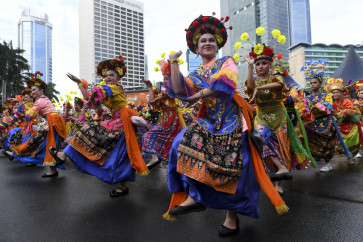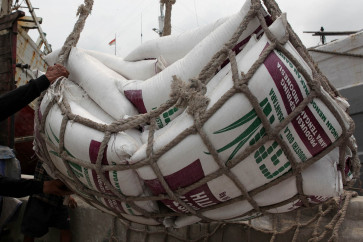Popular Reads
Top Results
Can't find what you're looking for?
View all search resultsPopular Reads
Top Results
Can't find what you're looking for?
View all search resultsBali holds rituals for IMF-WB meeting
The soothing sound of ceremonial bells filled the air around Bajra Sandi Monument in Renon, Denpasar, on Friday evening as around 2,000 people gathered to pray for the safety and success of the upcoming International Monetary Fund (IMF)-World Bank Annual Meetings
Change text size
Gift Premium Articles
to Anyone
T
he soothing sound of ceremonial bells filled the air around Bajra Sandi Monument in Renon, Denpasar, on Friday evening as around 2,000 people gathered to pray for the safety and success of the upcoming International Monetary Fund (IMF)-World Bank Annual Meetings.
The joint prayer was led by senior Hindu high priest Shri Bhagawan Putra Natha Nawa Wangsa Pemayun. Standing on the stage, he was flanked by 108 pemangku (temple priests), who continuously sounded their hand bells throughout the praying session.
“May the Lord Almighty bless the gathering and bestow the participants with good health and clear minds. May the Lord Almighty also protect us from any harm and animosity,” Shri Bhagawan said, before uttering the mantra for the well-being of all creatures.
Organized by the Bali administration, the joint prayer was attended by scores of high-ranking government officials, including Coordinating Maritime Affairs Minister Luhut Pandjaitan, Bali Governor I Wayan Koster, Bali Police chief Insp. Gen. Petrus Reinhard Golose and Udayana Military Command commander Maj. Gen. Benny Susianto.
Also in attendance were community and religious leaders as well as chiefs of customary villages. There are nearly 1,500 customary villages in Bali and they still wield a powerful influence on the Balinese.
“Through this joint prayer we would like to build a spirit of togetherness among all elements of the community. Let us show the world that Bali is able to host an important international gathering in a safe and peaceful environment,” Bali Governor I Wayan Koster said.
The joint prayer was part of a series of rituals held by the Bali administration to ensure the safety of the gathering, which is expected to attract nearly 20,000 people.
“In Bali, every endeavor must be carried out in both sekala and niskala,” Shri Bhagawan said, referring to the seen and unseen realms, respectively.
Balinese Hindus believe preparation in the niskala realm, such as notifying the island’s deities and holding the necessary rituals, are equally important as preparations in the sekala realm, such as the beefing up of security measures and construction of new infrastructure, in ensuring the success of an event.
The first niskala effort took place in early August when then-Bali governor Made Mangku Pastika and several IMF and World Bank officials attended matur piuning, a ritual to officially notify the island’s protecting deities, at Besakih, the island’s largest and most important temple complex. On the slope of Mount Agung, Besakih temple is the throne of the island’s supreme deity, Hyang Putrajaya.
On Sept. 24, a delegation of Bali officials led by newly installed Governor I Wayan Koster and Deputy Governor Cokorda Oka Artha Ardana Sukawati, visited three temples in Besakih compound; Hyang Aluh, Peninjoan and Pengukur-ukuran. The delegation prayed and presented offerings in those temples.
The niskala campaign will be continued on Oct. 3, during which Shri Bhagawan will lead a group of devotees in a spiritual pilgrimage to nine major temples: Pusering Jagat in Gianyar regency; Kentel Gumi and Goa Lawah in Klungkung; Sakenan in Denpasar; Uluwatu, Gunung Payung and Petitenget in Badung; Pekendungan and Batukaru in Tabanan.
Some of those temples were constructed by Danghyang Nirarta, a Hindu sage who arrived in Bali in the 15th century and later played an important role in the court of Dalem Waturenggong, one of Bali’s greatest kings.
“We will also organize a series of rituals at three temples that lie near the conference venues and hotels. Those temples are Meduwe Karang, Paduan and Geger,” Shri Bhagawan said.
On Oct. 5, the high priest will officiate nyengker, a specific ritual that aims to establish a spiritual wall of protection around the gathering’s main venues.
“On the same day, the six hotels hosting the delegates of the annual meetings, will present a pejati offering at their respective temples. The pejati will be kept in the temples until the end of the annual meetings,” he said.
Pejati comprises fresh flowers, leaves, rice, eggs, slices of banana and sugar cane, water and fire. Its most important element is daksina, a tiny basket filled with coconut and various seeds, threads and Chinese coins. In Balinese Hinduism, daksina represents the Lord Almighty. The offering of pejati, therefore, is seen as an act of inviting the presence of the Lord onto the premises.










